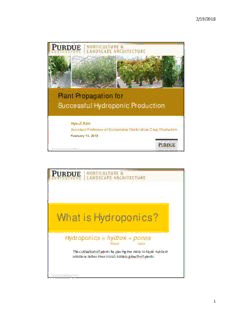
Plant Propagation for Successful Hydroponic Production_February 13, 2018_Hye-Ji Kim PDF
Preview Plant Propagation for Successful Hydroponic Production_February 13, 2018_Hye-Ji Kim
2/19/2018 Plant Propagation for Successful Hydroponic Production Hye-Ji Kim Assistant Professor of Sustainable Horticulture Crop Production February 13, 2018 Purdue University is an equal access/equal opportunity institution. What is Hydroponics? Hydroponics = hydros+ ponos Water labor The cultivation of plants by placing the roots in liquid nutrient solutions rather than in soil; soilless growth of plants. Purdue University is an equal access/equal opportunity institution. 1 2/19/2018 Why hydroponics? Crops can be produced on non‐arable land including land with poor soils and/or high salinity levels. Efficient use of water and nutrients. High density planting = minimum use of land area. Year‐round production. Local food. Direct and immediate control over the rhizosphere. Isolation from diseases or insect pests usually found in the soil. Higher yield, quality and storability of products. Ease of cleaning the systems. No weeding or cultivation is needed. Transplanting of seedlings is easy. Purdue University is an equal access/equal opportunity institution. Hydroponics Basics Types of Hydroponics: Water vs. Substrate-base Open vs. Closed Purdue University is an equal access/equal opportunity institution. 2 2/19/2018 Types of Hydroponics: Water vs. Substrate-base Water-based System Substrate-based System DDeeeepp wwaatteerr ccuullttuurree ““RRaafftt”” ssyysstteemm EEbbbb‐‐aanndd‐‐ffllooww NNuuttrriieenntt FFiillmm TTeecchhnniiqquueess ((NNFFTT)) AAeerrooppoonniiccss DDrriipp iirrrriiggaattiioonn Purdue University is an equal access/equal opportunity institution. Source: ChiwonLee Types of Hydroponics: Water vs. Substrate-base Water-based System DDeeeepp wwaatteerr ccuullttuurree ““RRaafftt”” ssyysstteemm NNuuttrriieenntt FFiillmm TTeecchhnniiqquueess ((NNFFTT)) AAeerrooppoonniiccss Source: ChiwonLee Source: hydrocentre.com.au Mobile channel systemSource: Petrus Langenhoven Facility of Great Lakes Growers, Burton, Ohio Purdue University is an equal access/equal opportunity institution. 3 2/19/2018 Types of Hydroponics: Water vs. Substrate-base Water-based System DDeeeepp wwaatteerr ccuullttuurree ““RRaafftt”” ssyysstteemm NNuuttrriieenntt FFiillmm TTeecchhnniiqquueess ((NNFFTT)) AAeerrooppoonniiccss • Excellent aeration • 65% less water use than other Traveling plant, hydroponic systems Epcot Center, Disney World Source: http://www.mosesong.com/ Purdue University is an equal access/equal opportunity institution. Source: ChiwonLeeSource: Neiker‐Tecnaliawww.basqueresearch.com/new/2172 Source: ChiwonLee Types of Hydroponics: Water vs. Substrate-base Substrate-based System EEbbbb‐‐aanndd‐‐ffllooww DDrriipp iirrrriiggaattiioonn GGrraavveellss,, CCooccoo CCooiirr CCrroouuttoonnss CCllaayy‐‐bbaallllss LLaavvaa‐‐rroocckkss Purdue University is an equal access/equal opportunity institution. Source: Petrus Langenhoven 4 2/19/2018 Types of Hydroponics: Open vs. Closed Open (Drain to Waste) system Closed (Recirculating) system e.g. drip irrigation e.g. deep water culture, NFT, aeroponics Hydroponic tank Air pump Nutrient Reservoir Nutrient Water pump Reservoir Water pump Closed systems use 20–40% less water and fertilizer than open systems Consistent monitoring and maintenance of electrical conductivity (EC) and pH is required. Purdue University is an equal access/equal opportunity institution. Types of Hydroponics: Open vs. Closed Open (Drain to Waste) system e.g. drip irrigation Nutrient Reservoir Water pump Source: Grodan DDrriipp iirrrriiggaattiioonn Purdue University is an equal access/equal opportunity institution. 5 2/19/2018 Types of Hydroponics: Open vs. Closed Open (Drain to Waste) system e.g. drip irrigation Nutrient Reservoir Water pump Source: Petrus Langenhoven DDrriipp iirrrriiggaattiioonn Purdue University is an equal access/equal oGpproertgu nLitoy ivnsetittutt/ioTnh.e Palm Beach Post via AP Source: abcnews.go.com Types of Hydroponics: Open vs. Closed Open (Drain to Waste) system to Closed system Nutrient Reservoir Water pump DDrriipp iirrrriiggaattiioonn Purdue University is an equal access/equal opportunity institution. 6 2/19/2018 Plant material preparation • Choice of Crops and Cultivars • Growing Media • Hydroponic Propagation Methods Purdue University is an equal access/equal opportunity institution. Preparation of plant materials Choice of Crops and Cultivars The most popular crops grown in hydroponics: tomatoes, cucumbers, lettuce, herbs, peppers, and strawberries F1 Hybrid Indeterminant growth Leafy vegetables and herbs High‐wire or vine plants Purdue UniversityP is alna equnal atccienss/egqua l doppeortunnity sinsitittutiyon.: 20‐25 plants/m2 Planting density: 4‐8 plants/m2 7 2/19/2018 Types of Growing Media Substrate choice for hydroponic seedling production Substrates can be used alone or in mixture with other substrates. Consider physical and chemical properties (air, water, and solid space; EC and pH), cost, local availability, compatibility with the production system Purdue University is an equal access/equal opportunity institution. Types of Growing Media Substrate choice for hydroponic seedling production Substrates can be used alone or in mixture with other substrates. Consider physical and chemical properties (air, water, and solid space; EC and pH), cost, local availability, compatibility with the production system Good physical contact with seeds Substrates Synthetic media Organic Mineral (plugs, cubes, and blocks) components components Conventional peat moss perlite • polymer bound plugs (e.g. peat hydroponics coco coir Vermiculite pellets, coir pellets, composted organic sand Clay pebbles material plugs, Oasis Horticubes, sawdust urethane foam plugs) rice hulls • Rockwool cubes & blocks • coco coir cubes and blocks Purdue University is an equal access/equal opportunity institution. 8 2/19/2018 Types of Growing Media Substrates for hydroponic propagation 1 2 3 Source: http://campus.extension.org/ “Rockwool system” LLoonngg‐‐tteerrmm ccrrooppss Purdue University is an equal access/equal opportunity institution. Source: Grodan Hydroponic Propagation Methods Grafting Pepper Cucumber Seed propagation High‐wire or vine plants Division Leafy vegetables and herbs Strawberries Purdue University is an equal access/equal opportunity institution. 9 2/19/2018 Hydroponic Propagation Methods Seed propagation Seed germination Relative humidity Temperature Light Leafy vegetables and herbs Large‐scale seed propagation Germination rooms Purdue University is an equal access/equal opportunity institution. Source: Bob Geneve Hydroponic Propagation Methods Seeding emergence Water and nutrient management Light: LED lights EC: 0.5 mS/cm EC: 1.0 to 1.5 mS/cm pH 6 pH 6 EC: 2 mS/cm pH 6 Purdue University is an equal access/equal opportunity institution. 10
Description: